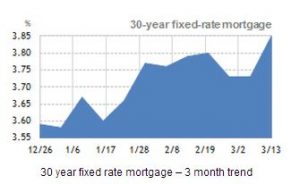Stocks up for the week – Stocks rallied on better than expected Chinese trade data which indicated that the China’s economy may not be hitting the “hard landing” investors has feared. At the same time U.S. manufacturing output unexpectedly dropped in March, as factory output dropped 0.3% in March. This held back the gains. The Dow Jones Industrial Average closed the week at 17,897.46, up from 17,576.96 last week. The S&P 500 closed the week at 2,080.73, up from 2,047.60 last week. The NASDAQ closed Friday at 4,938.72, up from 4,850.69 last week.
Bond yields lower for the week – The 10 year U.S. Treasury bond closed Friday yielding 1.76%, almost unchanged from 1.72% last week. The 30 year U.S. Treasury bond closed Friday yielding 2.56%, unchanged from 2.55% last week. Mortgage rates follow bond yields so we watch bonds carefully.
Mortgage rates remain near three year low -The Freddie Mac Primary Mortgage Survey released on April 7, 2016 showed that average mortgage rates from lenders surveyed for the most popular products were as follows: The 30 year fixed average rate was 3.58%. The 15 year fixed average rate was 2.86%. The 5/1 ARM average rate was 2.84%.
Have. Great weekend!
Syd

